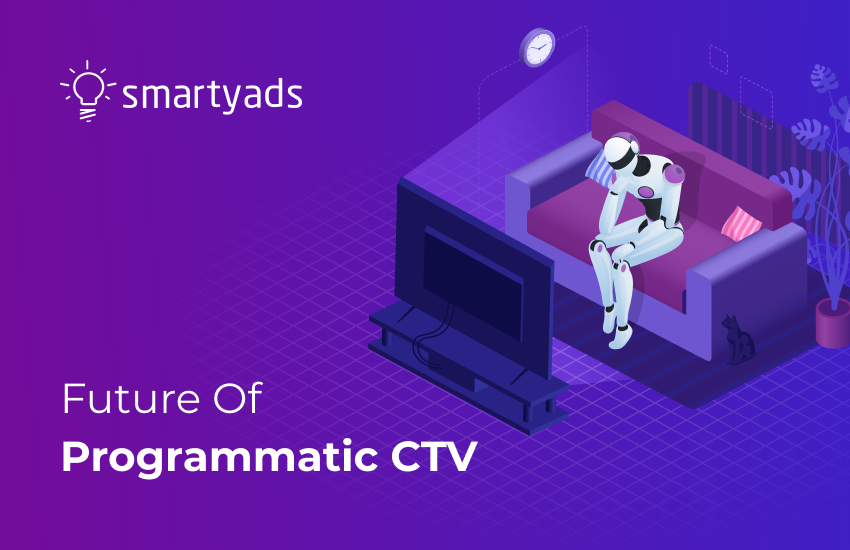Connected TV (CTV) popularity throughout the pandemic is only growing. It combines digital and linear media buying. With a smart TV, audiences can do the same thing on a smartphone, but only on a big screen: watch YouTube, use online cinemas, surf the Internet, and listen to music in Apple Music apps.
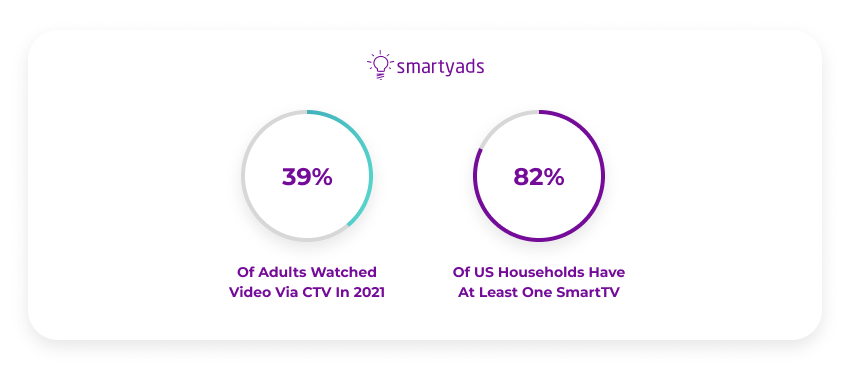
Currently, 39% of adults watch videos via CTV daily, and 82% of people have at least one Smart TV or TV connected to the Internet. In this order, CTV has become a profitable advertising tool you should pay attention to right now. So, what are the CTV ad benefits, what is the ad forecast, and how to maximize the ad revenue with CTV?
What is Connected TV?
According to the media buying glossary, CTV is used in the context of smart TVs and streaming devices that connect the Internet to the TV.
The CTV ecosystem includes:
- Smart TV, which includes inventory with an operating system for Internet access and connection to streaming platforms and services. Smart TVs will be considered CTVs only if they are connected to the Internet;
- Set-Top-Box (Streaming Stick)—a special inventory connected to the TV to access the Internet;
- Game consoles inventory — with them, you can play and stream video content.
What are the features of programmatic CTV?
What is programmatic advertising? It is also known as programmatic buying or programmatic marketing. This process involves buying and selling advertising inventory.
Programmatic CTV is one of the programmatic ad types based on the same mechanism: advertising is placed on media companies' platforms (streaming services). This advertising format is relevant for TV media and connected devices to the Internet. Compared to direct media buying, programmatic CTV is time-saving which is its main benefit.
Measurement instruments for programmatic CTV
Clicks are not a good indicator of connected TV ad campaigns' effectiveness. Clicks can only be measured on mobile devices where users can stream video. So what indicators for CTV campaigns are better?
In the case of a CTV ad, the business needs cost per completed view (CPCV), video completion rate (VCR), and CPM (cost per mille or cost per 1000 views) performance metrics. Advertisers can save more money if the cost-per-completed-view is lower.
Targeting several devices
CTV opens an incremental reach opportunity for targeting several devices. Data shows when watching TV, 90% of users use mobile phones. Marketers will need the so-called "double-check". It is when first advertising is shown to a certain segment of the CTV audience and then the same audience on mobile devices.
This feature allows marketers to understand the impact of CTV advertising better. Multiple devices can be targeted with a programmatic DSP. Additionally, programmatic advertising platforms can propose the option of anti-fraud mechanisms, as Ivan Guzenko (co-founder of SmartyAds) states.
How are CTV ads different from OTT ads?
OTT (over the top) is a video distribution service. You can consume video content with this method on any device (computer, smart TV, tablet, or smartphone). And while the audience is watching TV using a CTV device, they can consume OTT and CTV ads. The most famous OTT services are probably Netflix, Hulu, Amazon Prime, and Disney+.
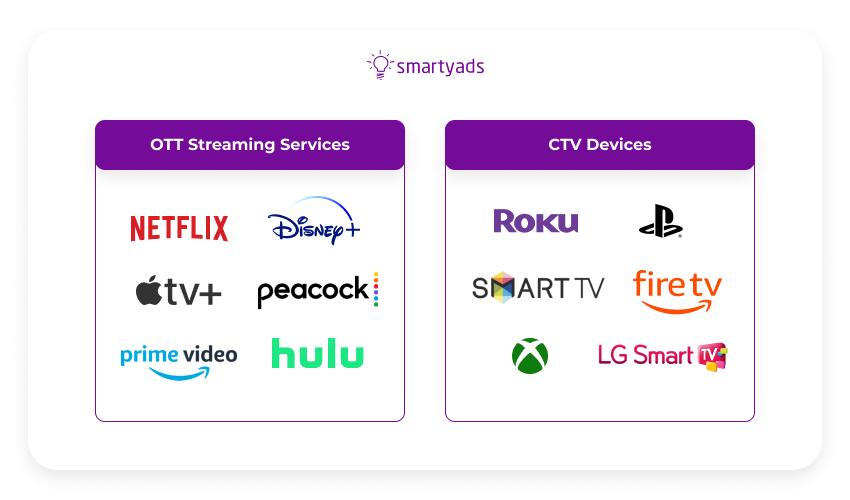
Compared to traditional methods, CTV and OTT advertisements are purchased and presented programmatically through the Demand Side Platform. So what is the difference between OTT and CTV ads? Because OTT (over the top) refers to how content is streamed (as opposed to the device on which it is viewed), marketers can reach audiences that don't have a TV in their homes.
What are the benefits of CTV ads?
Let's find out what is the success of CTV ads. Data shows that in 2022 76% of video marketers in any industry called connected CTV advertising a must-buy for their media plans. According to marketers’ research, it makes sense to use different strategies such as premium inventory and audience targeting with deep user involvement. They will provide advertising in a premium environment and minimize advertising costs.
In addition to the growth of CTV, there are four main benefits for advertisers to think about programmatic television advertising:
Automation of workflows
Marketers have always considered linear TV as a complex digital advertising preparation. With CTV, video publishers have the opportunity to simplify and automate programmatic ad buying and selling. CTV inventory can be placed through the same DSP and advertising networks that sell advertising. The advertiser's relevant message is conveyed to its intended audience via the media channels.
CTV viewers are very involved
Key insights of the State of CTV Advertising Report:
- viewing completion rate (88%) and engagement rate (3.4%) are 1.1 and 10.3 times higher in interactive CTV formats;
- advertisers need to use the network's proprietary data to create personalized ads in new and innovative ways.
So CTV users are highly motivated to watch the ads, and they will reach consumers and optimize your revenue.
CTV programmatic provides advanced audience targeting
With connected TV advertising platforms, advertisers have advanced tracking options such as location, lifestyle, demographics, Internet browser, search habits, etc. And then, programmatic TV advertising allows your brand to reach the relevant audiences on psychographic, demographic, and contextual parameters. It's the main reason programmatic TV is cost-effective compared to linear TV ads.
CTV programmatic guarantees a diverse and fast-growing audience
Connected TV guarantees the diversity of the audience. Your ad campaigns can reach both the older generation and young audience. Another benefit of programmatic television advertising is the fast-growing factor. The number of viewers (millennials) will grow to 62.6 million by 2025.
What is the ad forecast for CTV?
According to Statista, the digital ad industry will only grow, and $566 billion was spent on data-driven ad buying in 2022.
Data-driven CTV advertising solution offers you a good opportunity to reach your target audience with highly-targeted campaigns. But what is the forecast for connected programmatic television?
Revenue growth
In addition to the growth of CTV, in 2021 digital advertising revenue was projected to reach $16.6 billion. And it's not all data. During the next 5 years, revenue is expected to rise to an estimated $32.6 billion and these numbers will be higher each year.
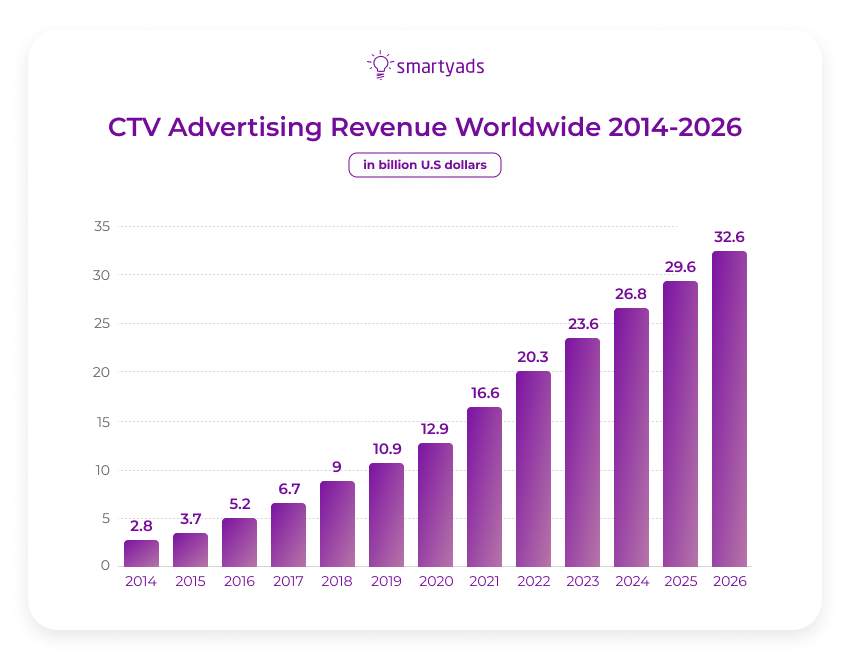
The video completion rate is higher
In addition to the growth of the CTV ad revenue, 64% of viewers are ready to watch the ad if they pay less. And this indicator will grow as more and more consumers switch to free and subscription-based video streaming platforms. This data influences the future of programmatic TV advertising and will be a great advantage for digital marketing and advertisers.
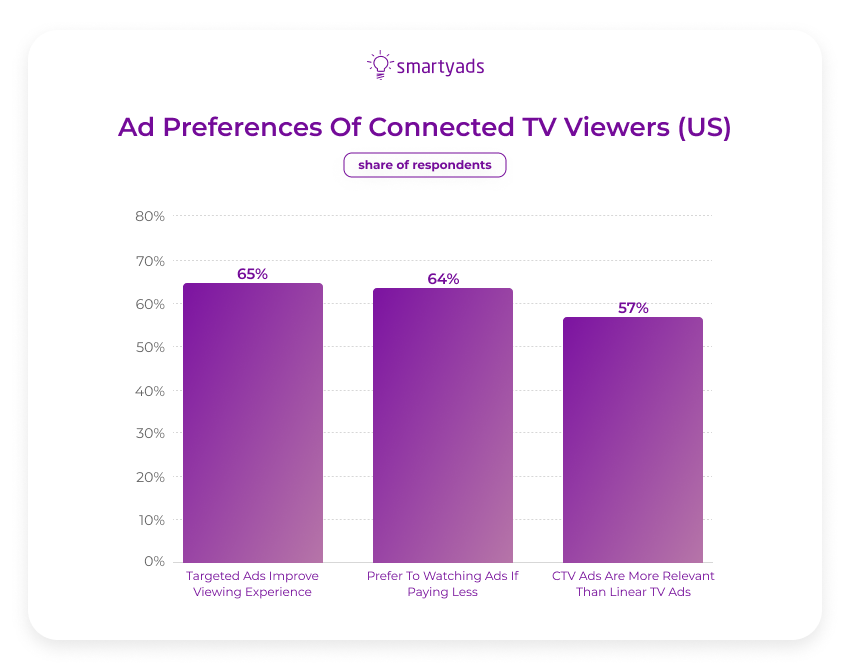
Challenges of programmatic TV advertising
To speak about challenges, let's look at key insights from a survey among the marketers who used programmatic ads:
- 48% of marketers noted that measuring across programmatic platforms and publishers was a challenge of connected TV advertising;
- 43% of marketers stated that the management of CTV advertising frequency is challenging;
- 34% of marketers named lack of scale.
So how to avoid the possible challenges and achieve the full potential of programmatic media buying?
What is the powerful solution for CTV advertising and monetization?
SmartyAds DSP supports all types of ads on connected TVs. On the SmartyAds demand side platform, media buyers and advertisers can deliver full-screen video advertising with the right message in primetime. By targeting potential consumers across multiple devices, CTV ads provide an effective and efficient way to reach them. You can cut through the chaos with the automation benefit of SmartyAds!
